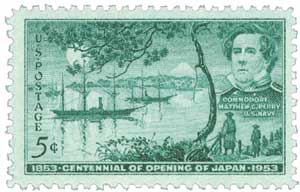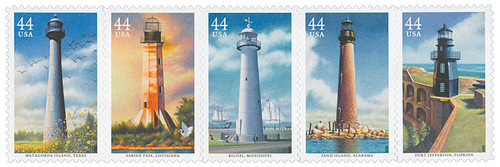
# 4413 - 2009 44c Gulf Coast Lighthouses: Fort Jefferson, Florida
Gulf Coast Lighthouses
Fort Jefferson, Florida
Issue Date: July 23, 2009
City: Biloxi, MS
Sent to survey the newly acquired cluster of reefs, islands, and shoals known as the Florida Keys, U.S. Navy Commander Matthew C. Perry recommended the construction of a lighthouse on Garden Key. Congress approved funding, and a 65-foot conical brick tower was completed in 1826.
The lighthouse was important for vessels traveling from the Mississippi River and Florida’s west coast, because they had to go around the islands before sailing up the eastern seaboard.
The U.S. government also recognized the strategic military value of the region – the nation that controlled it would also control navigation in the Gulf of Mexico. To safeguard American interests, work began at Fort Jefferson on Garden Key in 1846. Known as the “Gibraltar of the Gulf,” the fort enclosed most of the island’s 16 acres and its lighthouse.
The Fort Jefferson lighthouse was spared from any direct action during periods of war. However, over 2,200 prisoners were held within its walls, many during the Civil War. The compound also held four men convicted in the assassination of President Abraham Lincoln. Some years later, the USS Maine was part of a squadron stationed at Garden Key Island when it exploded and sank in the harbor of Havana, Cuba, igniting the Spanish-American War.
Birth Of Matthew C. Perry
Born to a naval captain, Perry was the younger brother of Oliver Hazard Perry. Navy life was in his blood and Perry began his career at the age of 15 as a midshipman aboard the USS Revenge, under his older brother’s command.
In the coming years, Perry served on several other ships, including the USS President, aboard which he was an aide to the Commodore. While on that ship, he took part in a battle against the British before the start of the War of 1812. He remained on that ship after the war started when the President fired the first shot of the war at the HMS Belvidera. Perry was later transferred to the USS United States, where he served under Stephen Decatur.
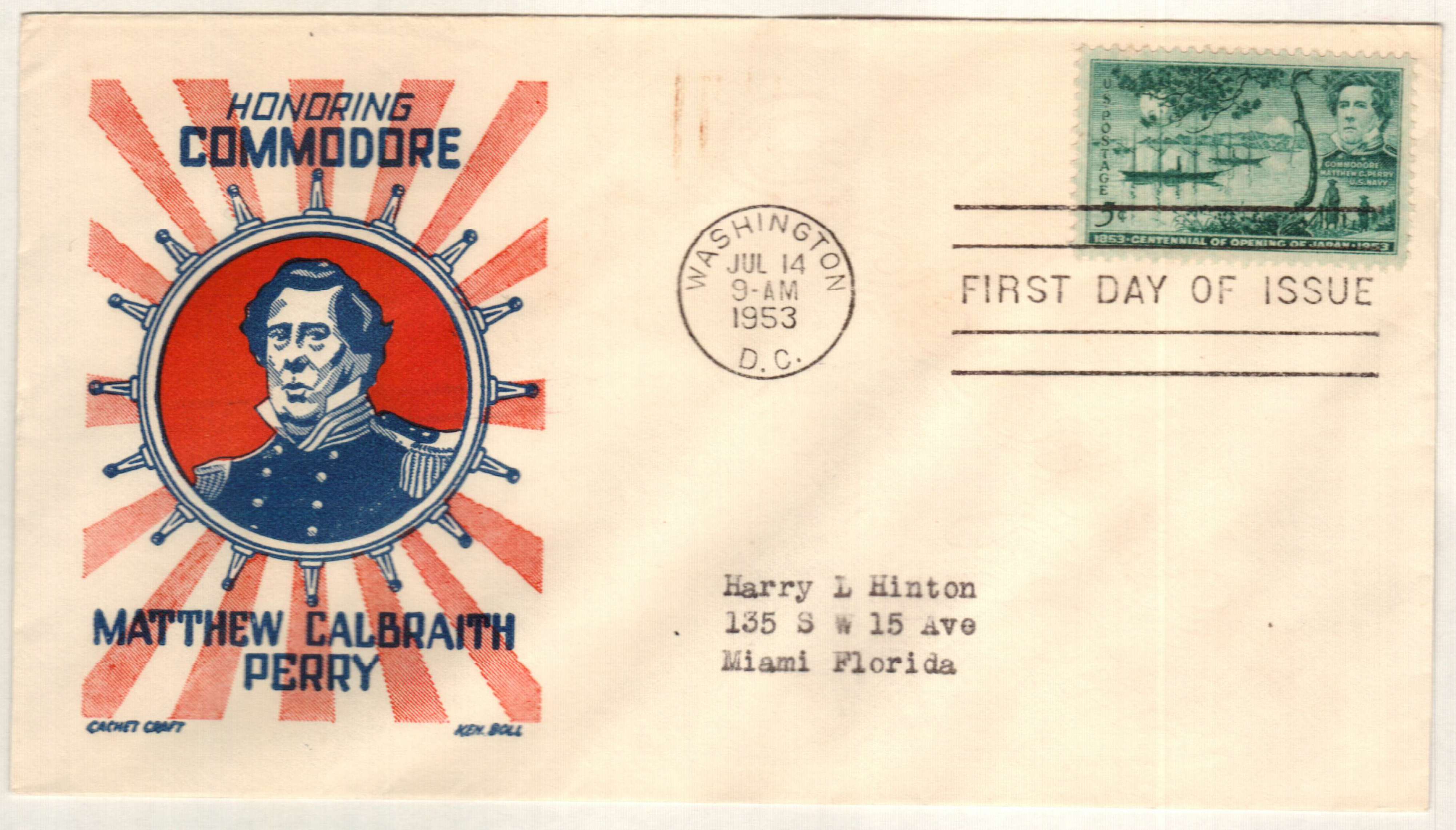
After the war, Perry served on several ships in the Mediterranean. He served under William Bainbridge in the Second Barbary War, took part in patrols off Liberia, and was offered a commission in the Imperial Russian Navy, which he turned down.
By 1821, Perry was in command of the USS Shark. The following year, he sailed the Shark to Key West, Florida to claim the Keys as United States territory. Perry then took command of the USS Concord, served as the second officer of the New York Navy Yard, and was promoted to captain.
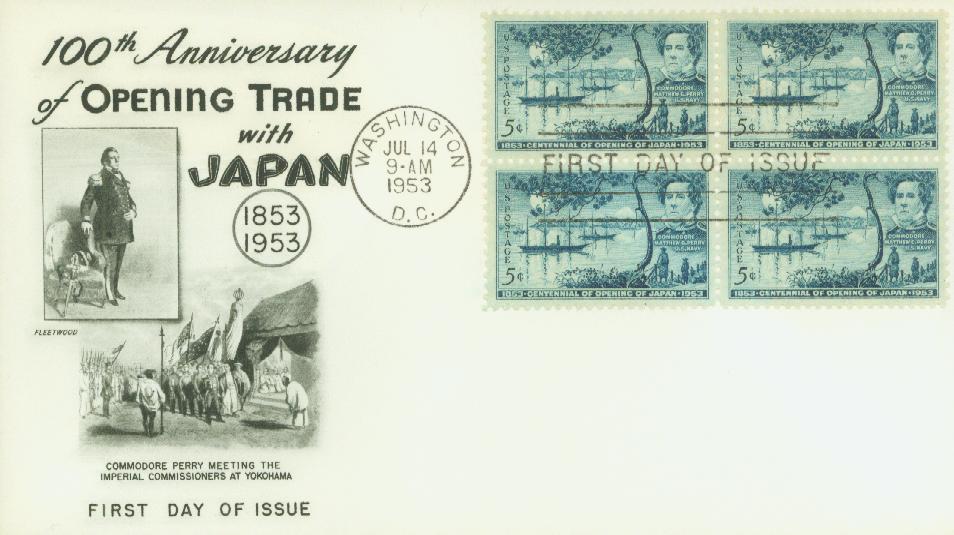
As a captain, Perry oversaw the construction of and then commanded the USS Fulton, the Navy’s second steam frigate. Perry recognized the importance of naval education and promoted an apprentice system to train new sailors. He helped create the course of study for the US Naval Academy, organized the first corps of naval engineers, led the first naval gunnery school, and pushed for the modernizing of the Navy. For his efforts, he was called the “Father of the Steam Navy.”
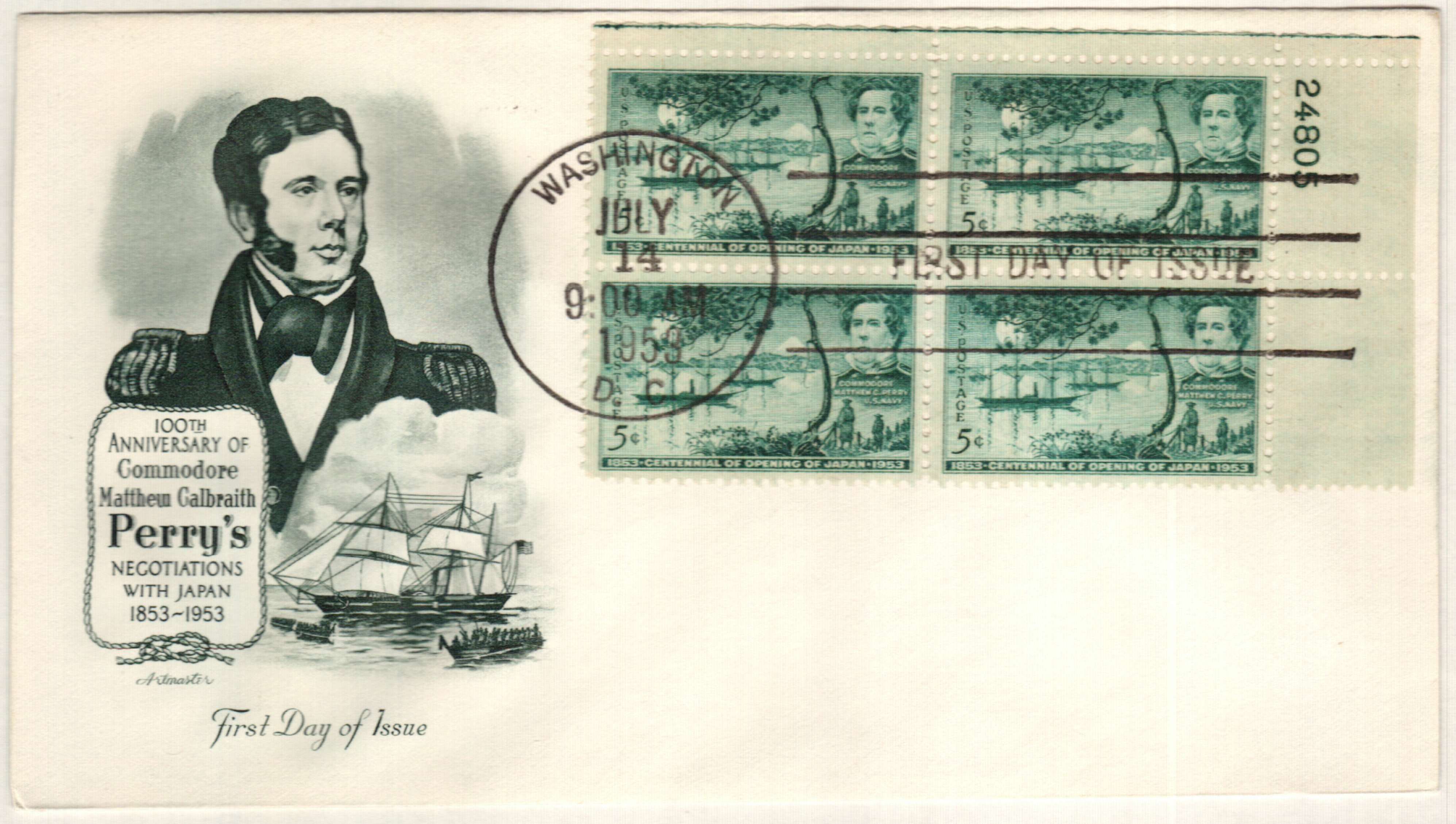
During the Mexican-American War, Perry was in command of the USS Mississippi. He captured Frontera and Tampico and fought at the First Battle of Tabasco. He also participated in the end stages of the siege of Veracruz before attacking other Mexican port cities and he personally led a landing force in taking San Juan Bautista.
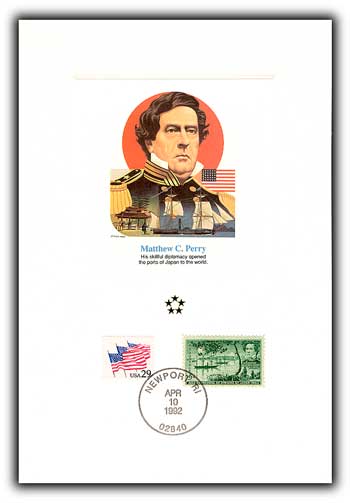
One of Perry’s most famous accomplishments came in the 1850s. Under the direction of President Millard Fillmore, he traveled to Japan to open relations. On July 8, 1853, Perry led four steamships into Tokyo Bay. The Japanese were impressed by the giant steamships, which they had never seen before and described as “giant dragons puffing smoke.”
When Perry arrived in Tokyo Bay (then called Uraga Harbor), he demanded to be allowed to present President Fillmore’s letter. His requests were rejected, so Perry opened fire with the ships’ cannons on several buildings. The Japanese realized they could not match the firepower of the American ships and allowed Perry to come ashore.
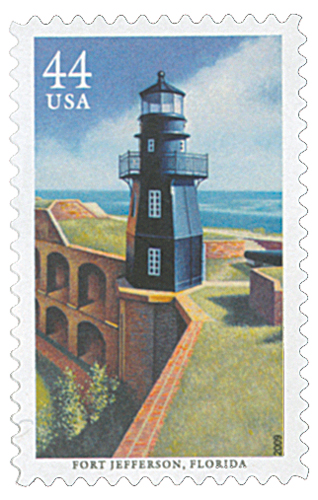
Perry then presented the letter, requesting that Americans stranded in Japan be returned home and expressing interest in opening trade between the two nations. He also presented the emperor with a variety of gifts, including a working steam locomotive model, a telegraph, a telescope, and several wines and liquors, all intended to show the Japanese the superiority of American culture and benefits of trade.

The following year, both sides signed the Treaty of Kanagawa, establishing peace between the two nations. The treaty also called for the opening of two ports to American ships, assistance and protection for American ships stranded in the area, and permission for American ships to buy supplies, coal, water, and other provisions in Japanese ports.
Upon his return to the US, Perry received a reward of $20,000, which he used to compile a three-volume report on his time in Japan. Perry finished his report just months before his death on March 4, 1858.
Gulf Coast Lighthouses
Fort Jefferson, Florida
Issue Date: July 23, 2009
City: Biloxi, MS
Sent to survey the newly acquired cluster of reefs, islands, and shoals known as the Florida Keys, U.S. Navy Commander Matthew C. Perry recommended the construction of a lighthouse on Garden Key. Congress approved funding, and a 65-foot conical brick tower was completed in 1826.
The lighthouse was important for vessels traveling from the Mississippi River and Florida’s west coast, because they had to go around the islands before sailing up the eastern seaboard.
The U.S. government also recognized the strategic military value of the region – the nation that controlled it would also control navigation in the Gulf of Mexico. To safeguard American interests, work began at Fort Jefferson on Garden Key in 1846. Known as the “Gibraltar of the Gulf,” the fort enclosed most of the island’s 16 acres and its lighthouse.
The Fort Jefferson lighthouse was spared from any direct action during periods of war. However, over 2,200 prisoners were held within its walls, many during the Civil War. The compound also held four men convicted in the assassination of President Abraham Lincoln. Some years later, the USS Maine was part of a squadron stationed at Garden Key Island when it exploded and sank in the harbor of Havana, Cuba, igniting the Spanish-American War.
Birth Of Matthew C. Perry
Born to a naval captain, Perry was the younger brother of Oliver Hazard Perry. Navy life was in his blood and Perry began his career at the age of 15 as a midshipman aboard the USS Revenge, under his older brother’s command.
In the coming years, Perry served on several other ships, including the USS President, aboard which he was an aide to the Commodore. While on that ship, he took part in a battle against the British before the start of the War of 1812. He remained on that ship after the war started when the President fired the first shot of the war at the HMS Belvidera. Perry was later transferred to the USS United States, where he served under Stephen Decatur.

After the war, Perry served on several ships in the Mediterranean. He served under William Bainbridge in the Second Barbary War, took part in patrols off Liberia, and was offered a commission in the Imperial Russian Navy, which he turned down.
By 1821, Perry was in command of the USS Shark. The following year, he sailed the Shark to Key West, Florida to claim the Keys as United States territory. Perry then took command of the USS Concord, served as the second officer of the New York Navy Yard, and was promoted to captain.

As a captain, Perry oversaw the construction of and then commanded the USS Fulton, the Navy’s second steam frigate. Perry recognized the importance of naval education and promoted an apprentice system to train new sailors. He helped create the course of study for the US Naval Academy, organized the first corps of naval engineers, led the first naval gunnery school, and pushed for the modernizing of the Navy. For his efforts, he was called the “Father of the Steam Navy.”

During the Mexican-American War, Perry was in command of the USS Mississippi. He captured Frontera and Tampico and fought at the First Battle of Tabasco. He also participated in the end stages of the siege of Veracruz before attacking other Mexican port cities and he personally led a landing force in taking San Juan Bautista.

One of Perry’s most famous accomplishments came in the 1850s. Under the direction of President Millard Fillmore, he traveled to Japan to open relations. On July 8, 1853, Perry led four steamships into Tokyo Bay. The Japanese were impressed by the giant steamships, which they had never seen before and described as “giant dragons puffing smoke.”
When Perry arrived in Tokyo Bay (then called Uraga Harbor), he demanded to be allowed to present President Fillmore’s letter. His requests were rejected, so Perry opened fire with the ships’ cannons on several buildings. The Japanese realized they could not match the firepower of the American ships and allowed Perry to come ashore.

Perry then presented the letter, requesting that Americans stranded in Japan be returned home and expressing interest in opening trade between the two nations. He also presented the emperor with a variety of gifts, including a working steam locomotive model, a telegraph, a telescope, and several wines and liquors, all intended to show the Japanese the superiority of American culture and benefits of trade.

The following year, both sides signed the Treaty of Kanagawa, establishing peace between the two nations. The treaty also called for the opening of two ports to American ships, assistance and protection for American ships stranded in the area, and permission for American ships to buy supplies, coal, water, and other provisions in Japanese ports.
Upon his return to the US, Perry received a reward of $20,000, which he used to compile a three-volume report on his time in Japan. Perry finished his report just months before his death on March 4, 1858.







